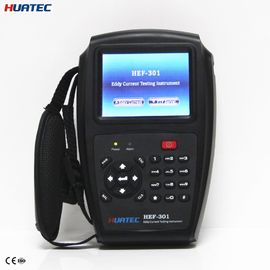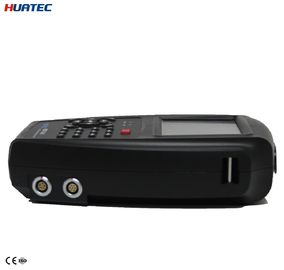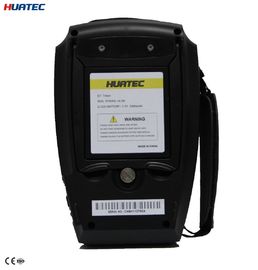Eddy Current ndt Testing Flaw Detector Eddy Current Test Equipment HEF-301
Nowadays, the eddy current testers used by NDT industries are either with too big body or without impedance display mode and advanced functions. These have influenced the applications of eddy current testing technology in aviati on, power, petrochemical and defense industry. With the improvement of electronic component integration, especially the creation of high-performance data acquisition system chip and low-power LCD monitor as well as high-energy battery, it makes the design of small and hand-held tester become more and more possible.
It has been proved by research that, operate sm art keyboards with thumb is much easier than with other fingers because it has less joints . HEF-301 takes this advantage to realize one-finger operation. Moreover, with the latest digital electr onic technology and
microcomputer technology, this instrument can offer not only extremely convenient operation, but also reliable and stable high performance.
HEF-301 is designed with advantages of impedance display mode, multi frequencies and micro power. It can be used for flaw inspection of metal materials and measure of cladding thickness and conductivity. The instrument case is made from light and wear-resistant material to make it sturdy and durable.
HEF-301 has high sensitivity for discontinuities of metal materials, such as cracks on copper pipe surface, puckers and scars of steel pipe, pits, scratches, wear scars, transverse fissures or separation layers etc.
Besides the man-machine dialog and the spec ial digital electronic balance technology, HEF-301 has a broad frequency range from 64Hz to 5MHz which is appropriate for inspection requrements of various metal materials. Since designed with full digital
technology, this instrument can create standard testing program for different size which can be used for future. The selection of probe completely depends on users’ testing requirements.
Specifications
Frequency range: 64 Hz~5 MHz (adjustable)
Gain range: 0~90 dB, adjustable in step of 0.5 dB
Phase rotation: 0~360 , adjustable in step of 1
Fast digital/analogue electronic balance
Impedance plan display window
Delay disappear of signal track
Menu type man-machine dialog
Communication by USB port (connect with USB and other removable storage devices) or network port (connect with PC)
Digital filter
Optional in absolute probe, differential probe and self- comparing probe
The alarm area is adjustable
Boundary dimension: 183x120x44 (mm)
Weight: 600g
Gross weight:4kgs
Menu page:

Structure of Eddy current flaw detector HEF-301:




Maintance
Keep the equipment clean with dustproof cover when it is not working.
Keep the equipment working for 1~2 hours every day in the rainy season to remove
moisture.
Make sure the equipment works in the environment without strong electromagnetic
interference, and make sure the equipment is well earthed to keep jamming signals away.
Please do not take the equipment apart to repa ir it. Once some malfunctions happen, please
read the guide book first, and find out the reason. Or ask the supplier for help.
Once users couldn’t expel the malfunctions, please send the equipment b ack to our company.
The warranty for the equipment is one year from the day it is shipped. If users store and
operate the equipment totally according to the guide book, we’ll be res ponsible for the repir
or the replacement of the equipment free under the warranty once there’s any quality
problem. After the expiration of the warra nty, we’ll charge for repair cost.
The equipment should be packaged and stored indoors. The indoor temperature is at -10 ℃~
+50 ℃, the relative humidity is not more than 85% RH, and there should not have enough
harmful substance in the air to cause corrosion.
When the equipment is sent back to repair, please pack it with the original case and liner to
avoid any damage in transit. We are not responsible for problems caused by unqualified
packing. Therefore, please keep the original packing case a nd liner for future use when
users get the new equipment out of package.
Please write the detailed delivery information on the packing case when the equipment is
sent back to repair, such as our company name , the address, the department, the contact and
the telephone number etc.

Optinal probes for HEF-301:


















Operation step for phase analysis of block defect
Instrument: HEF-301 eddy current tester
Probe: pencil probe with frequency 50k-500KHz
Block: Al block
Operation:
1. Select “DISP.”, and set “Disp.Mode” as “Line”.

2. Select “PARA.”, set “Freq.Val.” as 100KHz, “Filter” as 8, “Gain” as 40dB, “Lo.Pass” as 99.5Hz, other parameters as default.

3. Select “DEB.”, set “Pro.Gain” as 15dB, “Driver” as 3, other parameters as default.

4. Select “OTHE.”, set “Y/X Ratio” as 2.0 (usually the Y/X Ratio is between 2.0-5.0 for pencil probe, and 1.0 for welding probe), other parameters as default.

5. Exit by pressing three times of exit key. Press ↑ key to set the center point, a dialog box will come out. Press “OK”, and adjust the center point to the bottom right corner by pressing the four arrow keys.

6. Press Enter key to confirm. Place probe vertically on block area without defect, press BAL key and shake the probe, shaking signal will be on the screen. Select “ANAL.”, and adjust frame to select shaking signal. Adjust phase to make shaking signal to horizontal direction.

7. Enter into testing by pressing two times of exit key. Place probe on block area without defect. Shake the probe to see shaking signal on the level, and then scan the three cracks on the block.


 Your message must be between 20-3,000 characters!
Your message must be between 20-3,000 characters! Please check your E-mail!
Please check your E-mail!  Your message must be between 20-3,000 characters!
Your message must be between 20-3,000 characters! Please check your E-mail!
Please check your E-mail! 













